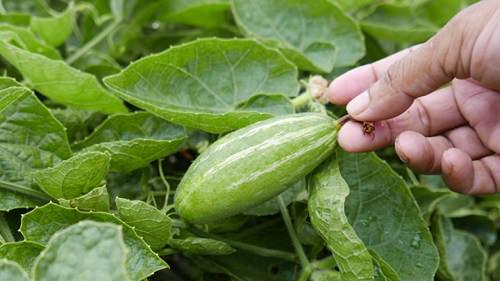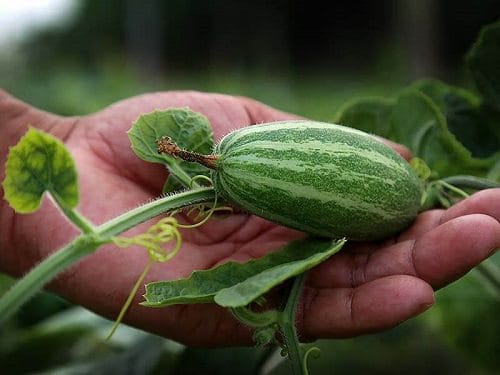Enjoy this cucurbitaceous vegetable in a variety of cuisines by learning everything about Growing Pointed Gourd in this article!
Pointed gourd is a vine that is similar to cucumber and squash. It is a good source of vitamins and minerals and widely used in soups, stews, curries, and desserts. The plant is also known for its ability to lower the total cholesterol levels and blood sugar in the human body. If all this has tempted you to plant it too, then have a detailed look at Growing Pointed Gourd.
Common Names: Green potato, Parval
Size: 5-7 feet
Planting Time: February to March
What is Pointed Gourd?

The pointed gourd is a perennial vine from the family Cucurbitaceae. It produces 2-6 inches small or long green fruit with white stripes. The fruit can be thick or round and grows on the trellis.
The pointed gourd is native to the eastern and northern parts of India. Many Indian preparations like soups, stews, curries, and desserts use it extensively. This gourd variety is also a rich source of several vitamins, minerals, and carbohydrates.
How to Grow Pointed Gourd
Climate
The pointed gourd is commonly grown in tropical and subtropical regions when the climate is hot and humid. This vining plant goes dormant in winter, hence planting and harvesting need to be done before climate turns cold. If you are looking forward to having the crop in the same year, plant when the danger from frost is over in the spring.
Propagation
Pointed gourd can be propagated through seeds, cuttings, and root suckers.
From Seeds
- Get seeds from a garden center to grow the plant. You can also use the seeds from a ripe pointed gourd fruit.
- Soaking the seeds overnight increases the chances of successful germination.
- Sow them directly in the garden or pot.
- When young plants grow 5-6 leaves, thin out the weak ones.
- After 2-3 weeks of sowing, the young plants will be ready for transplanting.
Propagation from cuttings is easy. Take 5-6 inches of cutting from a plant and use them growing. To propagate the plant from root suckers, dig out the tuberous roots in the early spring. Subdivide and replant them.
You can also grow it by purchasing a plant from a nearby nursery or online store.
Requirements for Growing Pointed Gourd

Location
Choose a spot where it receives plenty of sunlight. The plant can grow in the shade but will not produce fruit. Protect the vines from the afternoon sun, when the roots are establishing.
Soil
The ground prefers a well-drained sandy loam soil with good manure to boost soil fertility. A pH ranging from 5.5 to 6.7 will be the best for the plants. If growing in containers, use well-draining, loose soil. For a bountiful harvest, enrich the soil with organic matter.
Watering
In the initial growth stage, water every 3-5 days. When the plant starts to flower and fruit, increase the rate to every alternate day. Keep the soil evenly moist but not waterlogged.
Support
The pointed gourd is a vine and requires support to grow and climb. Install a stake or frame on the planting site or arrange a trellis. Prune or pinch the vines when they reach the top of the trellis support. This will help the plant to direct its energy towards more flowers and fruits.
Pointed Gourd Care

Fertilizer
Combine a lot of rotted manure or compost during planting. To give a plant an additional boost, you can apply an all-purpose fertilizer during transplanting. If the plant shows a weak growth, you can feed again. Side-dress the plant with compost or well-rotted aged manure, once or twice in a year.
Pests and Diseases
Fruit flies, Red beetles, Insects, and Epilachna can affect pointed gourd. Be careful about the diseases like downy mildew and mosaic virus. Spray an insecticide to get rid of them.
Harvesting and Storage
In optimum conditions, pointed gourd vines begin to fruit in approx 90-120 days after planting. Use a sickle or handpick the fruits. Harvest when they are green and young. Don’t keep them for long as it will deteriorate the taste. You can store them in the refrigerator for 2-3 days.
Growing Pointed Gourd in Pots

If you do not have enough space to grow pointed gourd, you can grow it in pots as well. The process is easy and can be done in limited space.
- You will need a large, 16-20 inches pot with drainage holes. When the plant becomes bigger, transplant it to a larger pot.
- Use a sandy, loamy, well-draining soil and blend it with compost or aged manure.
- Place the pot where it receives plenty of sunlight.
- Keep the soil moist but not waterlogged.
- Support the plant with a trellis or wire so it can climb and use vertical space.



Where I can buy pointed groud .
Where I can buy pointed groud.
Thank you for writing this blog post. I loved it and I have a question please help me . I Have planted pointed gaurd on my garden 4 Months ago. Now the plants have grown up . But they are not flowering . What should i do ? I have searched entire internet but not much of helpful information. Please help
I received pointed gourd bulbs, two different kinds may be male and female. Could you please show me a picture showing which one is which and how to plant it? Thank you. KANIZ.
Where you got this can u please suggest